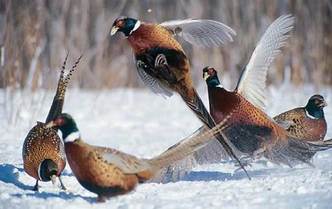It seems that the original version was a love song to the birds that were often found not only in the backyards and woods, but also on the holiday tables of feasting families.
You will be familiar with the first seven choruses/courses, as they are the usual fare ; ^)
Cheers!
**********************************************************************************
On the first day of Christmas my true love sent to me A Partridge in a Pear Tree
The partridge is a member of the pheasant family and has been a traditional game bird in England for centuries. The partridge referred to in the carol is most likely a Grey Partridge (Perdix perdix) or English Partridge. Partridges are usually ground birds who feed on seeds and insects so we are not sure why it would be sitting in a pear tree.
On the second day of Christmas my true love sent to me Two Turtle Doves
The Turtle Dove (Streptopelia turtur) is a common summer visitor to England. It is a dainty dove, smaller and darker than most other pigeons but would have been featured in banquets in medieval times just as today we eat pigeon.
On the third day of Christmas my true love sent to me Three French Hens
There are a four well-known breeds of French hens; Faverolles, La Fleche, Crevecoeurs and Marans. Faverolles have superior egg-laying ability during the winter months so would make an ideal gift for someone's true love at Christmas.
On the fourth day of Christmas my true love sent to me Four Calling Birds
Most people interpret a calling bird as a song bird. However, the original song referred to "Four Colly Birds". The word colly means "black as coal or soot" so it is likely that the gift was four blackbirds (Turdus merula). We know that blackbirds were eaten in the past from the children's nursery rhyme "Four And Twenty Blackbirds Baked In A Pie".
On the fifth day of Christmas my true love sent to me Five Gold Rings
The gold rings are not in fact pieces of jewelry as the literal meaning would have you believe but are actually ring-necked birds. These are most likely to be Common (Ring-necked) Pheasants (Phasianus colchicus) which were introduced to England from China in medieval times. Pheasant is still a popular game bird eaten today.
On the sixth day of Christmas my true love sent to me Six Geese-a-Laying
The geese in this verse are probably domesticated birds so are likely to be the Greylag Goose (Anser anser), the ancestor of our domesticated geese. The Greylag Goose is a large, native British bird and is still traditionally eaten for Christmas.
On the seventh day of Christmas my true love sent to me Seven Swans-a-Swimming
Nowadays Mute Swans (Cygnus olor) are protected birds but there are many surviving medieval recipes for swans. One such recipe says that "Swan was quite often served as an ordinary dish, without the head......". Swan was roasted along with peacocks, storks and other birds that we would never consider eating today.
On the eighth day of Christmas my true love sent to me Eight Maids-a-Milking
Cattle egrets (Bubulcus ibis) are small birds with yellow or greyish legs and a yellow beak. As their name suggests, cattle egrets tend to live near cattle as the animals' hooves disturb invertebrate prey. They are visiting the UK in increasing numbers and we think they are an appropriate bird to represent the maids in the carol.
On the ninth day of Christmas my true love sent to me Nine Ladies Dancing
Many birds perform dances particularly during courtship rituals. Although regarded by some as black, sinister and greedy, cormorants (Phalacrocorax carbo) have a distinctive bobbing stance when dancing which we think looks quite ladylike.
On the tenth day of Christmas my true love sent to me Ten Lords-a-Leaping
Grey herons (Ardea cinerea) are tall, with long legs, a long beak and grey, black and white feathering. To take flight a heron must leap into the air and when standing, hunched with their neck bent over their chest they look just like old men.
On the eleventh day of Christmas my true love sent to me Eleven Pipers Piping
Sandpipers (Actitis hypoleucos) make a distinctive three-note piping-like cry as they take off. It is a smallish wader with contrasting brown upperparts and white underparts. Sandpipers habitually bob up and down, known as 'teetering', and they have a distinctive flight with stiff, bowed wings.
On the twelfth day of Christmas my true love sent to me Twelve Drummers Drumming
We think the best contender for the drummer is the great-spotted woodpecker (Dendrocopos major). They spend most of their time clinging to the side of tree trunks and branches trying to hide from observers and predators although they will venture into gardens to feed at bird tables and feeders. The presence of a great-spotted woodpecker is often announced by its loud call or by its distinctive spring 'drumming' display.






 RSS Feed
RSS Feed
